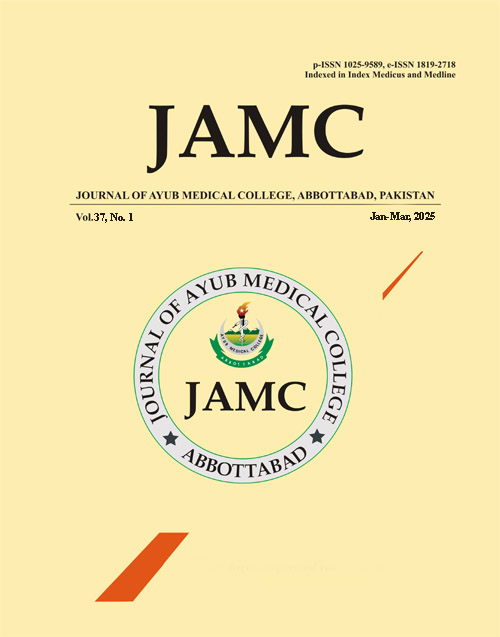A CASE REPORT OF MUCINOUS TUBULAR AND SPINDLE CELL CARCINOMA OF THE KIDNEY
DOI:
https://doi.org/10.55519/JAMC-01-14039Keywords:
Mucinous Tubular and Spindle Cell Carcinoma, renal tumor, partial nephrectomy, rare case reportAbstract
Mucinous Tubular and Spindle Cell Carcinoma (MTSCC) is a rare renal tumour, accounting for 1% of renal tumours. We report a 35-year-old female presenting with right flank pain and a 6.3 cm exophytic hypodense enhancing mass in the upper pole of the right kidney. Histopathology revealed characteristic tubular and spindle cell morphology with mucinous stroma, confirming MTSCC. Surgical resection via partial nephrectomy led to favourable prognosis. This case highlights MTSCC's distinctive features, diagnostic challenges, and importance of accurate diagnosis for optimal management.
References
1. Ordonez NG, Mackay B. Renal cell carcinoma with unusual differentiation. Ultrastruct Pathol 1996;20(1):27–30.
2. `Eble JN. World Health Organization classification of tumours. Pathology and genetics. Tumours of the urinary system and male genital organs: 2004; p.10.
3. Srigley JR, Delahunt B. Uncommon and recently described renal carcinomas. Mod Pathol 2009;22(Suppl 2):S2–S23.
4. Xiao-Long Q, Ming Z, Xiang-Lei H. Mucin-poor mucinous tubular and spindle cell renal cell carcinoma with sarcomatoid transformation and multiple metastases: report of a unique case and review of literature. Int J Clin Exp Pathol 2016;9:2451–8.
5. Hanan F. Mucin poor mucinous tubular and spindle cell carcinoma of the kidney, with nonclassic morphologic variant of spindle cell predominance and psammomatous calcification. Ann Diagn Pathol 2012;16(1):59–62.
6. Park SY, Kang GH, Ro JY, Black J, Chung J, Lee KH, et al. Mucinous Tubular and Spindle Cell Carcinoma of Kidney Occurring in a Patient with Pulmonary Adenocarcinoma. Kor J Pathol 2008;42(1):54–9.
7. Arafah M, Zaidi SN. Mucinous Tubular and Spindle Cell Carcinoma of the Kidney with Sarcomatoid Transformation. Saudi J Kidney Dis Transpl 2013;24(3):557–60.
8. Banyai D, Vastag F, Yusenko M, Bugert P, Kovacs G. Embryonal origin of MTSCC of kidney may explain its morphological heterogeneity: diagnostic impact of genetic analysis. Anticancer Res 2017;37(3):1185–9.
9. Zhao M, He XL, Teng XD. Mucinous tubular and spindle cell renal cell carcinoma: a review of clinicopathologic aspects. Diagn Pathol 2015;10:168.
10. Ferlicot S, Lupo A, Lazure T, Bedossa P, Vieillefond A. A novel entity: low-grade mucinous tubular renal carcinoma. Histopathology 2005;47(2):218–9.
Downloads
Published
How to Cite
Issue
Section
License
Copyright (c) 2025 Jawad Khan, Malik Furqan Mahmood, Ikhtiyar Muhammad, Mudassar Abbas, Fatima Inam

This work is licensed under a Creative Commons Attribution-NoDerivatives 4.0 International License.
Journal of Ayub Medical College, Abbottabad is an OPEN ACCESS JOURNAL which means that all content is FREELY available without charge to all users whether registered with the journal or not. The work published by J Ayub Med Coll Abbottabad is licensed and distributed under the creative commons License CC BY ND Attribution-NoDerivs. Material printed in this journal is OPEN to access, and are FREE for use in academic and research work with proper citation. J Ayub Med Coll Abbottabad accepts only original material for publication with the understanding that except for abstracts, no part of the data has been published or will be submitted for publication elsewhere before appearing in J Ayub Med Coll Abbottabad. The Editorial Board of J Ayub Med Coll Abbottabad makes every effort to ensure the accuracy and authenticity of material printed in J Ayub Med Coll Abbottabad. However, conclusions and statements expressed are views of the authors and do not reflect the opinion/policy of J Ayub Med Coll Abbottabad or the Editorial Board.
USERS are allowed to read, download, copy, distribute, print, search, or link to the full texts of the articles, or use them for any other lawful purpose, without asking prior permission from the publisher or the author. This is in accordance with the BOAI definition of open access.
AUTHORS retain the rights of free downloading/unlimited e-print of full text and sharing/disseminating the article without any restriction, by any means including twitter, scholarly collaboration networks such as ResearchGate, Academia.eu, and social media sites such as Twitter, LinkedIn, Google Scholar and any other professional or academic networking site.










